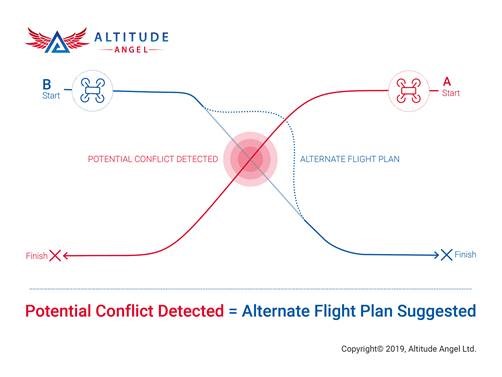Altitude Angel has added tactical deconfliction in a second phase development of its Conflict Resolution Service (CRS) launched in July 2019, initially addressing ‘Strategic’ deconfliction. With the introduction of ‘Tactical’ deconfliction, CRS extends beyond the pre-flight phase into airborne operations. Tactical deconfliction is designed to provide live alerts when boundaries between remote ID transmitting drones intersect and also offer alternative flight-plans in real-time – enabling pilots to avoid in-air collisions. As the programme expands over the coming few months, Tactical CRS will also help to deconflict drones against aircraft with transponders, as well as drones which don’t have remote ID flying in the vicinity of Altitude Angel’s planned sensor network which will come on-line in spring 2020. The service is global in its application.
The Tactical Deconfliction service is available as an API and is expected to help drones ‘deal with the unexpected’, such as manned aircraft, drones and obstacles or airspace closures which weren’t foreseeable before the flight happened, or, would previously have been managed by a human pilot. Altitude Angel says the technology can assist automated drones flying BVLOS.
Tactical CRS offers implementors a choice about the level of capability they wish to utilise, as well as to have the service deconflict against just their own drone fleet, or against all those been shared publicly. Altitude Angel is launching the Tactical deconfliction service as part of an exclusive access programme (EAP). Early adopters include Animal Dynamics, Herotech8, and drone operations management platform, DroneCloud.
CRS comes in two classes:
Tactical CRS: Tactical CRS provides information to drone pilots or the drone itself to ensure separation is maintained during the in-flight phase. The dynamic system will continuously monitor the airspace around a drone for the ‘unexpected’, such as other aerial vehicles or changes to airspace (such as a Temporary Flight Restriction/Dynamic Geofence around a police incident). After identifying a potential conflict, CRS will make the necessary routing adjustments via instructions or alerts which are communicated to the pilot in command or to the drone’s control software, allowing the drone to maintain an appropriate distance between other airspace users or fly around restricted airspace so it can continue safely (and efficiently) to its destination. Tactical CRS respects the implementor’s choices for privacy and control and is intended to supplement any on-board sense-and-avoid technologies, which usually only operate in close proximity to other air traffic.
Strategic CRS: Conflict resolution information is provided to a drone operator during the flight planning phase (pre-flight phase) of the operation by comparing it to other previously submitted flight plans, against ground and airspace geofenced areas available in Altitude Angel’s worldwide data feeds. The system will then propose alterations to the take-off time and/or route to eliminate the conflict, suggesting minimally invasive changes to permit the mission to continue unobstructed. Developers and drone manufacturers can utilise CRS to securely share flight plan data and opt-in to ‘global conflict resolution’, where all flight plans which have been shared will be checked for conflicts. ‘Private’ modes exist for fleet operators who only want to check for conflicts against their own drones or customers.
For more information visit:




